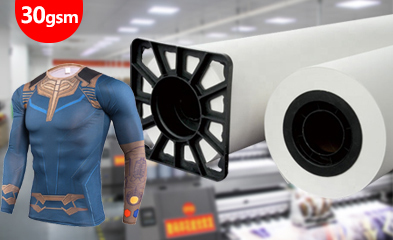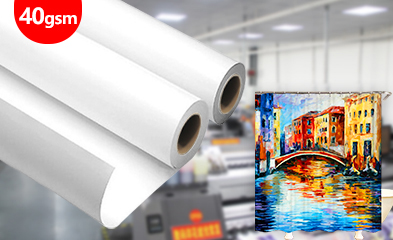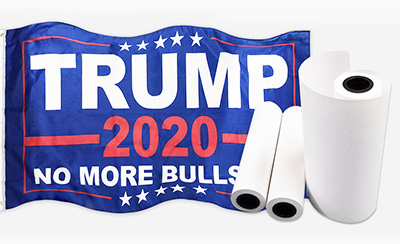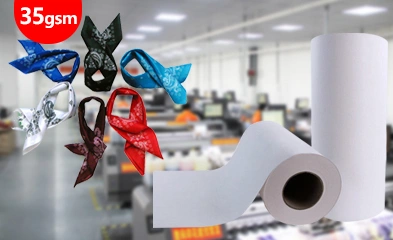HOT SALE
APPLICATION
Phone:+86-15215969856 E-Mail: 396838165@qq.com
The world of custom apparel printing has been revolutionized by full color heat transfer paper, an affordable solution for creating professional designs on cotton fabrics—enabling the precise application of detailed artwork, photographs, and complex graphics with long-lasting results. Mastery of the heat transfer process is essential for top outcomes, whether for small businesses, professional printers, or craft enthusiasts. This paper works best with cotton (a widely used material for custom apparel, promotional items, and personalized gifts), and following correct methods from preparation to finishing ensures transfers retain bright, fade-resistant colors through multiple uses and launderings.

Preparing for the Heat Transfer Process
The quality of your final product depends on proper preparation because it establishes the base for successful heat transfer operations.
Choosing the Right Full Color Heat Transfer Paper for Cotton
The selection of suitable transfer paper determines the best outcome for printing on cotton materials. The paper requirements for light-colored cotton differ from dark-colored cotton because each type functions best with particular ink systems and heat application conditions. The paper weight together with its coating quality and release properties determine how well the transfer process will turn out. The selection process depends on three essential factors which include garment purpose and washing expectations and final appearance requirements.
Selecting Compatible Tools and Equipment
The equipment configuration you choose will determine the success of your transfer operation. A heat press machine with precise temperature management and uniform pressure application stands as the fundamental requirement for successful operations. The equipment needs digital printers that support transfer paper dimensions and suitable ink solutions to achieve both ink bonding and color accuracy. Our team offers 24-hour support so you can reach out to us at any time for assistance with choosing the right equipment for your needs.
Pre-washing and Prepping the Cotton Fabric
The preparation of cotton fabrics needs particular steps to achieve their best transfer adhesion results. The pre-washing process eliminates all manufacturing substances and sizing chemicals and shrinkage problems which impact transfer quality. The washing process should use a gentle detergent that does not contain fabric softeners because these substances interfere with transfer adhesion. The fabric needs to dry completely and remain flat before starting the transfer application process.
Designing and Printing Your Artwork
The process of making high-quality artwork and getting perfect print results depends on proper application of design principles and printing technical specifications.
Creating High-Quality Artwork for Vibrant Transfers
The quality of transfer results and visual appearance depends heavily on the design preparation process. The use of high-resolution images at 300 DPI or higher will produce transfers with clear and non-pixelated images. The process of color profile management and monitor calibration helps to achieve precise color accuracy in your designs. The printing process requires designers to mirror their artwork horizontally because transfer papers need this specific orientation for successful application.
Printer Settings and Tips for Optimal Print Results
The configuration of printers determines how well ink saturates and how accurately colors appear and how well prints resist damage during transfer. The best print results emerge when you select either “best” or “photo” quality from your print settings. The ink density needs to be adjusted to stop excessive saturation because it causes bleeding and poor transfer release. Your printing process will achieve both safety and quality through the use of environmentally friendly solvents which are non-toxic and safe.
Handling and Storing Printed Transfer Paper Properly
The process of proper handling protects both print quality and prevents damage until the application stage. The drying time for printed papers depends on ink coverage and environmental conditions and should take between 15-30 minutes before handling. The storage area for printed transfers needs to be free from dust and moisture while keeping them protected from sunlight and humidity. The use of protective sheets between multiple prints helps stop ink transfer and prevents the prints from sticking together.
Applying Full Color Heat Transfer Paper to Cotton
The application process needs exact control of time, temperature and pressure to produce expert-quality results.
Setting Up the Heat Press Machine Correctly
The process of heat press calibration produces dependable and uniform transfer results. The infrared thermometer serves as a verification tool for temperature accuracy because built-in gauges tend to produce incorrect readings. The entire platen surface needs to receive equal pressure distribution for proper operation. The press needs to reach its recommended temperature before starting transfers while it stabilizes at that temperature for an adequate period.
Positioning the Transfer Paper on the Fabric
The exact placement of designs prevents alignment problems which results in a professional-looking finish. Design elements need to be centered through the use of alignment guides and measuring tools. The transfer paper needs to stay fixed in place but you should avoid using adhesives because they could disrupt the transfer process. The design process requires consideration of how garment construction elements such as seams and pockets will affect the transfer of pressure.
Time, Temperature, and Pressure Guidelines for Application
The optimal transfer parameters depend on paper type and fabric weight and the desired outcome. The transfer process for most cotton materials needs temperatures between 350-375°F (175-190°C) with medium to high pressure for 10-15 seconds. The transfer process requires 150C temperature and 15s transfer time for particular transfer film applications. You should consult the manufacturer’s guidelines for your transfer paper and make adjustments through experimental testing.
Post-Transfer Finishing Techniques
The correct finishing methods help maintain transfer durability while creating a professional-looking result.
Peeling Methods: Hot Peel vs. Cold Peel
The specifications of transfer paper sheets determine which peeling technique should be used. Users must remove hot peel papers right away when the transfer reaches temperatures between 2-3 seconds after pressing. Users must let cold peel papers cool down for 30-60 seconds before attempting to remove them. The incorrect peeling technique will lead to transfer failure and poor adhesion between the transfer and its surface.
Curing and Sealing the Design for Durability
The process of transfer application requires additional curing steps to achieve maximum durability in certain cases. A second pressing operation with parchment paper helps to enhance bond strength and defend the design from damage. The transfers need to dry for 24 hours before their first wash to achieve complete adhesion. High-wear situations require protective measures for transfer applications.
Washing and Care Instructions for Long-Lasting Prints
The duration of transfer life depends on following correct care instructions. The Sunproof Level 6 and Washproof Level 4-5 ratings of textile materials after transfer indicate that high-quality transfers can last long. The recommended washing method includes cold water and inside-out washing with a mild detergent. The transfer material will remain intact when you avoid using bleach and fabric softeners and dry items at low temperatures.
Introducing Changfa Digital as a Trusted Supplier
Professional results depend on using dependable materials and equipment from reputable suppliers who have demonstrated their ability to deliver reliable products.
Reliable Source of Sublimation Paper, Printers, Inks, and Heat Press Machines
Changfa Digital operates as a professional sublimation paper manufacturer which provides digital printing services for more than 15 years. The company operates as a factory that produces sublimation papers starting from base paper production through coating and slitting processes before shipping products worldwide. The company’s long history of operation has built reliable supply networks which deliver high-quality products for expert users. Changfa Digital provides sublimation transfer paper products with weights ranging from 40gsm to 100gsm for achieving uniform printing results.
Commitment to Quality and Innovation in Heat Transfer Solutions
The Changfa Digital facility operated four coating lines and maintained four slitting workshops with ten slitting machines that processed 2 and 3 core packing rolls. The standard export package includes core caps which are placed on pallets. The company brought in one German-made coating line which operates daily to produce sublimation paper. The factory produces 3000 Tons of products throughout each month. The factory operates with high production volume through its multiple coating lines and slitting workshops which maintain continuous product delivery of high quality. The factory operates with four coating lines and four slitting workshops to manufacture 3000 tons of products which it distributes worldwide.
Conclusion
Mastering the application of full color heat transfer paper on cotton requires careful attention to each step, from selecting the right paper and equipment to precise design preparation, printing, and application techniques. By following the outlined process—choosing compatible materials, prepping fabrics, calibrating the heat press, and adhering to proper curing and care instructions—you can achieve vibrant, durable, and professional-quality transfers. Partnering with a trusted supplier like Changfa Digital ensures access to high-quality sublimation papers and equipment, supporting consistent results for both hobbyists and professionals. With these practices, your custom cotton apparel will maintain its vivid colors and durability through repeated use and washing, delivering lasting value and visual appeal.
FAQs
Q1: What type of printer is best for full color heat transfer paper?
A: Use inkjet printers with pigment-based full-color inks for better durability and color fastness. Ensure the paper thickness matches your printer’s specs, adjust print quality settings, and opt for a printer with steady ink flow, 360dpi resolution, and capabilities like 20-meter uninterrupted printing for professional results.
Q2: Can full color heat transfer paper be used on dark cotton fabrics?
A: Yes, but use dark-specific transfer paper (with a white base layer for color visibility). Note that its application and washing instructions differ from light fabric transfers.
Q3: How to prevent designs from cracking or fading when washing?
A: Follow precise parameters like temperature, time, and pressure during application. Wait 24 hours to wash, use cold water, turn garments inside-out, avoid bleach/fabric softeners, and dry on low heat. Pair high-quality materials with correct methods for long-lasting results.















